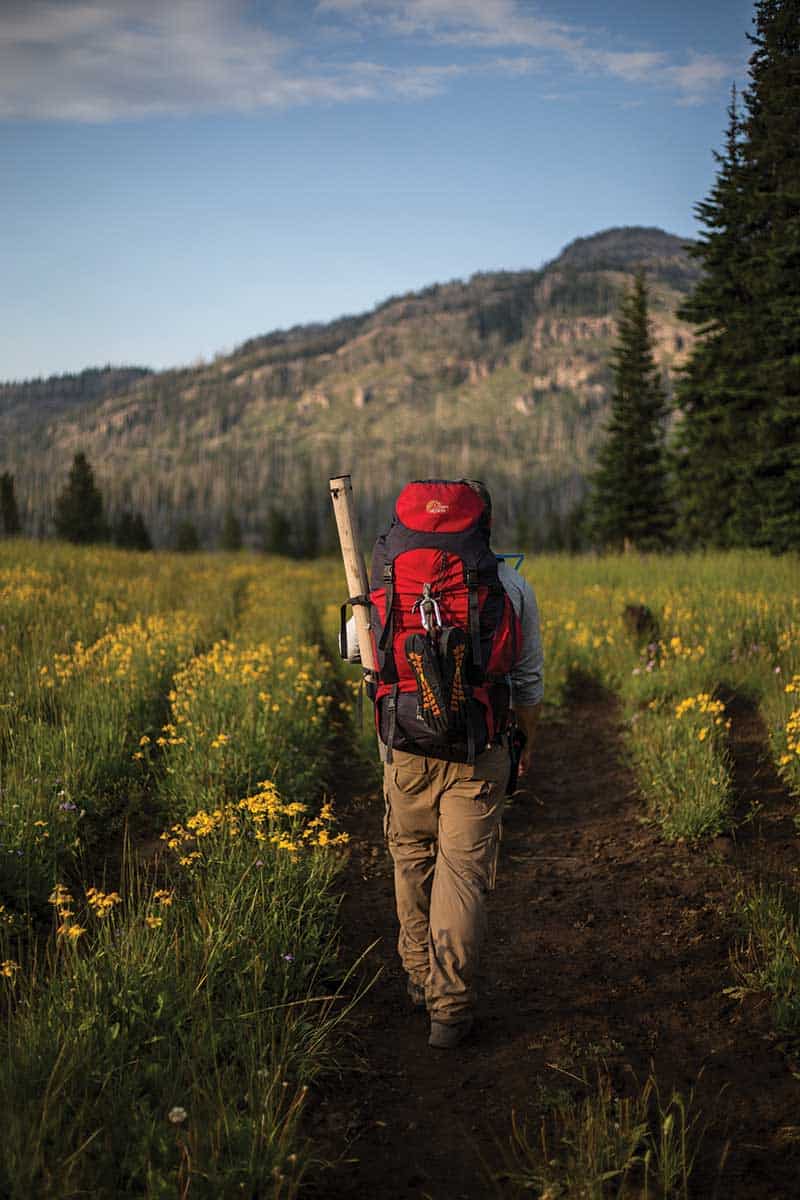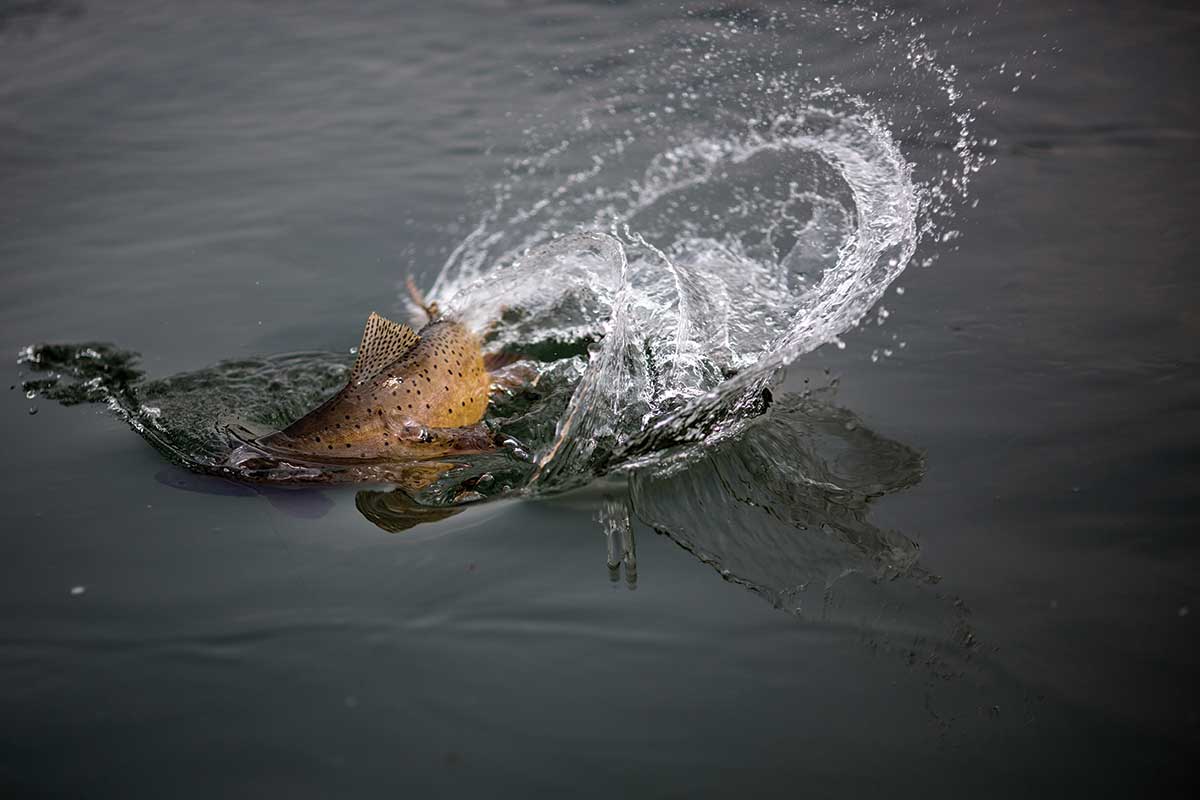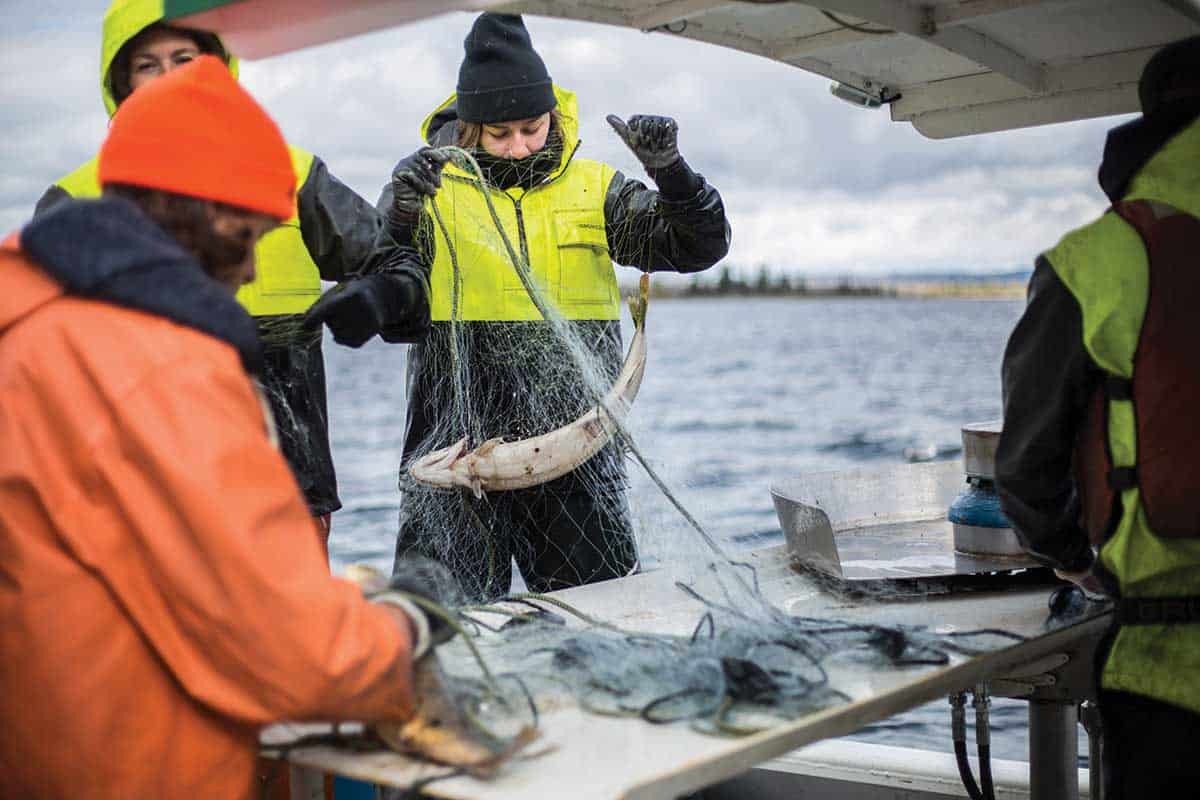Read The
Current Issue
The Comeback of the Cutthroat
An exotic species crashed the upper Yellowstone River’s native cutthroat trout population, but decades of aggressive eradication efforts aimed at the invasive fish have morphed the remote river back into a bucket-list destination for anglers.
By Mike Koshmrl
Photography by ryan dorgan

Alongside photographer Ryan Dorgan, I stalk the banks of the sluggish, coiled upper Yellowstone River just south of Yellowstone National Park. We’re looking for signs of the iconic Yellowstone cutthroat trout, a strain of the Greater Yellowstone Ecosystem’s only native trout species and a prized target of anglers. It doesn’t look promising. We’ve walked the river’s banks for hundreds of yards only to be greeted by slow-going, featureless “frog water” that clearly lacks fish. Then, past a broad bend, we see fish rise, sipping bugs from the surface of a deep run off the far bank.
We—me, my fly rod- and camera-wielding comrade Dorgan, and this pod of cutthroat trout, or “cutties”—are deep in the Teton Wilderness in the Bridger-Teton National Forest. We’re about twenty-five miles upriver from where the Yellowstone River dumps into North America’s largest high-elevation lake, Yellowstone Lake. Although not outlined as such on U.S. Geological Survey maps, this is the heart of a region known as the Thorofare, which is generally considered to be the upper Yellowstone River drainage, including its major tributaries, the largest of which is Thorofare Creek. Dorgan and I and the cutties journeyed long and hard to get here. Assuming the latter arrived here from Yellowstone Lake, they traveled the twenty-five miles packing sperm or eggs and an innate drive to run upstream to procreate. Dorgan and I backpacked in twenty-eight miles from Turpin Meadow, humping food for five days and camera, camping, and fishing gear that easily clears a hundred pounds.
A trout finally slurps up Dorgan’s buoyant Parachute Adams fly as it drifts past. Hooked, the fish reveals that, despite its long swim, it has plenty of fight left. We reveal that we packed for this adventure haphazardly. A true catch is thwarted not only by the fish’s fight, but also by our lack of a landing net. The big cutthroat evades Dorgan’s swiping hand, snaps his tippet, and escapes. But I don’t have to see it landed to know it’s one of the biggest cutties I’ve ever seen.
We should be disappointed but aren’t. After all, the Thorofare is a bucket-list destination for both of us. By one measure, it is the most remote place in the Lower 48 states: Hawks Rest, the 9,700-foot cliff band that towers over us, is the farthest you can get from a road in the contiguous U.S. We’re here fly fishing, on a river we have to ourselves, for a species of trout naturally found nowhere else in the world. Had we come forty years ago, we wouldn’t have had to look so hard for fish, but we would have been sharing the river with plenty of other anglers. Twenty years ago, anglers and Yellowstone cutties were in equally short supply. Today, the subspecies is coming back, and fishermen are just starting to realize it. Right now might be the most perfect time to fish the Thorofare.
Outdoor writer Charles Hallock, in an 1884 article in The American Angler, is credited with first giving cutties their common name. Hallock came up with “cutthroat” because the fish have distinctive red, pink, or orange linear marks along the underside of their mandibles.
THE UPPER YELLOWSTONE River watershed before it reaches Yellowstone Lake has been called the best cutthroat trout fishery on Earth. The Yellowstone strain of cutthroat here is genetically pure, whereas in some other parts of their range they’ve hybridized with rainbow trout, creating “cutbows.” Historically, the numbers of them here were, to use a scientific term, incredible. But just for a while each year. The big Yellowstone River itself doesn’t have many “resident” fish. About eleven months of the year, the upper Yellowstone’s cutthroat live in Yellowstone Lake. Just a few cutthroat live in the Thorofare year-round, and those are generally smaller fish in small streams. Only four of ninety-five cutthroat that Yellowstone fisheries biologist Brian Ertel captured and tracked one season stayed in the river system throughout the year. The rest were Yellowstone River sojourners, swimming upstream to lay their eggs and deposit sperm on gravels. This—the spawn—is when the Thorofare becomes the best cutthroat trout fishery on the planet.
Or that’s when the Thorofare used to be the best cutthroat trout fishery on the planet.
It’s impossible to guess how big the upper Yellowstone River cutty spawn was historically. The watershed upstream from the lake is too big and too remote to make such an assessment worthwhile. But there are some numbers for other tributaries flowing into Yellowstone Lake: In 1945 the park began monitoring the spawning run at Clear Creek, just one of the fifty-nine streams the species historically uses to spawn. The documented number of cutties spawning there peaked in 1978, at more than seventy thousand, but by the mid-2000s fewer than six hundred fish were making the same journey—a crash of more than 99 percent.
The reason for this population decline was never a mystery (but it did go unnoticed for almost a decade): In the mid-1980s, lake trout, a large, toothy, fish-eating species not native to the Rocky Mountains, showed up. It’s believed a scofflaw “bucket biologist” moved them illegally from Lewis Lake to Yellowstone Lake, though the theory has never been proven. (In 1890, the park had introduced lake trout into its Lewis and Shoshone Lakes, both of which were historically fishless.) A long-lived species, lake trout that reach trophy proportions can tip the scales at more than forty pounds and stretch the tape to fifty inches. And they’re usually fish eaters. One Yellowstone Lake study found that the big trout, also called mackinaw, ate an average of forty-one cutthroat trout annually. More recent research determined they’ve largely shifted their diets to “scuds,” a freshwater shrimp-like critter. Yellowstone Lake’s mackinaw population grew exponentially, swelling from an estimated 130,000 fish in 1998 to 800,000 by 2012. It’s stayed around that level since, though the average size of individual lake trout is falling.
It wasn’t just mackinaw that were eating Yellowstone Lake’s cutties out of a home, though. A long-term drought across the Intermountain West hurt populations, as did the arrival of the exotic, microscopic parasite Myxobolus cerebralis, which can cause fish to get whirling disease, an infection that bends a trout’s spine and causes it to swim in circles. Because infected fish cannot effectively feed, the disease is often fatal. Native to Europe, whirling disease is now found in waters in about half of the U.S. states.
Cutties are considered a “keystone species” in the upper Yellowstone River watershed, and their decline caused a ripple effect throughout the animal kingdom. This “trophic cascade” affected an estimated forty species like birds, bears, river otters, and mink, many of which lost a key food source. This dynamic relationship explains the “Lake trout kill elk” bumper stickers seen on cars and trucks around Jackson Hole. Grizzly bears abandoned former cutthroat-crammed spawning streams in the springtime in favor of feeding on elk calves. As the cutthroat population crashed, the osprey that fed on the species left. (In 2001, between fifty and sixty pairs of ospreys nested around Yellowstone Lake; in 2015 there were fewer than five.)
Managers have been netting and killing lake trout in Yellowstone Lake since their presence was discovered and confirmed in 1994, but for many years the efforts were inadequate to make a dent. Early on, the park’s fisheries biologists naively thought they were getting a handle on the lake trout population, unknowing they were on the front end of an exponential growth curve. Todd Koel, the Yellowstone staffer who’s been in the middle of the fight for eighteen years, recalls that in 2002, when fishing boats caught and killed around twelve thousand mackinaw, they were certain the population was near collapse. “Man, were we wrong,” Koel says. The lake trout kept showing up, and spreading, and so they ramped up netting pressure dramatically.
Now more than 300,000 lake trout are caught and killed each summer by contracted commercial fishermen imported from the Great Lakes. (The caught fish don’t go to market, but instead are dumped dead right back into Yellowstone Lake, which is another story in itself.) Although overall lake trout numbers are about as high as they’ve ever been, the number of large macks, which eat the most fish, has fallen off. Finally, cutthroat are showing signs of bouncing back, and they’re now about twice as numerous as they were in the early 2000s. The lake’s improved population has translated to more fish—and better fishing—in the Thorofare.
“ALL THE INDICATIONS and the reports that we’re receiving in the last handful of years is that [cutty] fishing has improved dramatically compared to the mid-2000s,” says Sam Hochhalter, a Cody-based fisheries supervisor for the Wyoming Game and Fish Department. In Yellowstone Lake’s smaller tributaries, where the cutthroats are easily counted, the aquatic migrations are steadily coming back. “But it still isn’t the glory days of pre-lake trout, where catch rates were really high and anglers were having thirty-, forty-, fifty-fish days. Those days are still in the past.”
While in the Thorofare ourselves, Dorgan and I run into someone who experienced these glory days, Leland Christensen, a Wyoming state senator and horseman who has rarely missed a summer trip into Hawks Rest since he first came more than thirty years ago. Christensen remembers his second-ever trip here, when he sat on the riverbanks with a North Carolinian friend and caught one cutthroat after another. “We caught eighty-two straight fish without missing,” he says. “We were doing it together, just laughing. We were hooking them, popping them off, hooking them again.” They weren’t small fish either. Outfitters say typical cutthroat that run from the lake into the Yellowstone River stretch anywhere from eighteen to twenty-two inches, though one study put the average spawning fish at sixteen inches. Since it’s not the 1970s and because Dorgan and I have missed the peak spawn, we don’t expect any fifty-fish days.
Some Thorofare travelers miss the spawn on purpose. Others miss it because of the vagaries of Mother Nature. (Dorgan and I miss it because of work and other obligations.) Latecomers might be motivated by that fact that cutthroat are not the only thing plentiful during the peak spawn; at that same time mosquitoes are said to ascend from the massive wetlands surrounding the river in clouds that would make the Arctic tundra proud. But by August, when most spawners are back in the lake, the bugs aren’t a problem. While the peak of the spawn is generally late June through early July, every summer is different and at the whims of runoff and water temperatures.
Ertel studied cutthroat spawning migration in the upper Yellowstone River system in-depth, sharing his results in a recent edition of the North American Journal of Fisheries Management. In the span of three weeks, the river-running trout cover an average of more than fifty straight-line miles in a round trip. To figure this out, a multiagency crew of fisheries biologists caught nearly one hundred cutties, implanted them with telemetry sensors, and then tracked them from airplanes flown a few hundred yards over streams. This research cohort of fish entered the upper Yellowstone during the first two weeks of June. By July 10, most of them were back in Yellowstone Lake. By August 1, just eleven of the tracked fish remained in the river. Two stragglers were detected in the river in September. The reason for the exodus is uncertain, but Hochhalter’s hunch is that it’s a product of a healthy, connected fishery—cutthroats are safer, have more food, and spend less energy in the lake, and so they go.
“I think it’s really a statement of having large, intact, and interconnected habitats,” he says. “When you grant individuals the option of migrating to more choice habitat, they’re just going to do it.”
Even if you guess right on runoff and water temperatures, there could be remnants of winter to contend with. The winter before I went in, a near-record snowpack left mountain passes impassible and rivers raging as the main spawn came and went. Chris Hart, a Forest Service horsepacker and patroller, persevered through this lingering snow and high water to get to his patrol cabin at Hawks Rest. He spent the first three weeks of July there and saw only five people. On the most commonly used trail from Jackson Hole into the Thorofare, he passed the hydrological oddity known as the Parting of the Waters, a National Natural Landmark where North Two Ocean Creek splits into Pacific Creek and Atlantic Creek; the former empties into the Pacific Ocean and the latter into the Atlantic. Descending Atlantic Creek, Hart made “first tracks.”
“Usually this place is overrun by then,” Hart tells me over a glass of whiskey at his patrol cabin. “It was so nice. So nice.”
Of course, the crowds are all relative. Don’t mistake the Thorofare, under any circumstances, for Jenny Lake. One of Hart’s first visitors was a grizzly. “I was having a cup of coffee and went to put some dishes in the sink and it pops up right there in the window,” Hart says. “I went ‘oh, shit,’ and backed up, and he said ‘oh, shit,’ and ran up the hill.” Later, although the water was still ripping by and clouded with sediment—unfishable, by most standards—Hart threw a lure into the Yellowstone River to see if he could catch a fresh meal. Out came a cutthroat.
The annual cost of Yellowstone’s lake trout eradication program is about $2 million.
AS LITTLE DATA as there is on Yellowstone cutthroat populations in the Thorofare, there’s even less data on the number of human travelers here. No permits are necessary to visit and camp in the area and going there without an outfitter is free. Wilderness rangers and patrol cabin volunteers do consider Hawks Rest to be the busiest spot in the 585,000-acre Teton Wilderness. When pressed for an estimate, they say about 11,000 people annually visit here, and that 80 percent or more of these come in on horses. Also, commercially outfitted visitors outnumber do-it-yourselfers two to one. If these guesstimates are accurate, just 750 private hikers a year make it to Hawks Rest. In our five days in the area during primetime backpacking season, Dorgan and I stumble into just a handful of folks a day—Christensen’s camp, a Wyoming Catholic College orientation class, a couple of outfitter groups, and a smattering of fragrant Continental Divide Trail thru-hikers. Dedicated overnight angling parties are wholly absent, as far as we can tell.
The solitude is surprising and striking given the grandeur of the landscape, which to me is reminiscent of Alaska and, well, pretty grand. It is also surprising given the Thorofare’s history. The name “Thorofare” comes from the fur-trading era, when it was a relatively busy place for frontiersmen trying to make a buck, and Thorofare Creek offered the easiest passage over the Absaroka Range. Today the Thorofare is home to the full suite of native terrestrial wildlife that lived there before pioneers settled the West. This includes an unnerving concentration of grizzly bears. There’s no estimate for the number of hump-backed bruins that live here, but multiple, chronic clashes with elk hunters each fall attest to their abundance.
In modern times, it was the early twentieth century up until the 1980s when the Thorofare was a thoroughfare, bustling with backpackers, anglers, and hunters willing to endure the all-day horse trip or the even longer hike to get there. “It was just camp after camp after camp back then,” Christensen says. “Once you hit Atlantic Creek, almost every little spot there’d be a camp.” The 1988 wildfires, which swept across much of the Teton Wilderness and over a third of Yellowstone National Park, thinned the crowds a little. The concurrent decline in spawning runs meant the number of anglers also fell off. Backpacking as a general pursuit has also declined, and some people theorize that locally backpackers have steered clear due to the rise in the Teton Wilderness’ grizzly population.
This meant that by the 1990s and 2000s and even early 2010s, the Thorofare was less of a thoroughfare, though commercial overnight trips were always a fixture, as were elk hunters’ spike camps come fall. Those who know it best say it’s getting busier. Dorgan and I run into one outfitter, Boulder Basin Outfitter’s Carl Sauerwein, who says he doesn’t even bother with the mainstem of the upper Yellowstone River when he’s guiding hardcore fishermen during peak spawn. He’s got other Teton Wilderness haunts—I still don’t know the locations—where there’s similar-quality fishing and his clients don’t have as much competition from fellow anglers.
The allure of the trip is the unrefined adventure, and it certainly isn’t for everyone. The upper Yellowstone’s muddy banks were just as marked with grizzly tracks as boot prints when we visited. I duped a single cutthroat that wasn’t spotted in the water beforehand. The fish was a hog, like the rest of them, and I hit it in fast water on the hike out, as an ominous wall of clouds was building to the west over Two Ocean Plateau, home to the trickle of water that eventually becomes the Snake River. It buckled my four-weight rod and had me trotting down a sandbar to give it line before I brought it to hand, and it scurried off back to its haunt in the current. I’d like to think it wasn’t much later that the cutty’s instincts kicked in, and it swam all the way back to Yellowstone Lake.
CUTTHROAT FAMILY
The 2002 book Trout and Salmon of North America recognizes fourteen subspecies of cutthroat trout, or “cutties.” Each subspecies is native to a unique geographic area, but no native populations are found outside of the western U.S. It was probably a cutty that was the first trout encountered by Europeans in the New World: In 1541, Spanish conquistador Francisco Vázquez de Coronado recorded seeing trout in a river near Santa Fe, New Mexico. These were most likely Rio Grande cutties.









